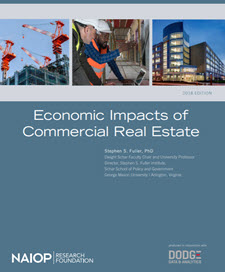Tax reform enacted late last year will cause investment in nonresidential structures to increase by an average of more than $23 billion from 2019-2028, and rise nearly $10 billion this year alone, according to new projections released Monday by the Congressional Budget Office (CBO). (The Budget and Economic Outlook: 2018 to 2028, April 9)
 |
CBO chart: Effects of the 2017 Tax Act on Investment Through Changes in Incentives affecting Nonresidential and Residential Structures. Click to Enlarge— Page 119 of full CBO Report |
The new report isolates and analyzes the impact of recent tax reform legislation on different types of economic activity, including investment in structures.
Tax reform’s positive impact on nonresidential investment stems from the corporate and individual rate reductions, as well as the new pass-through deduction. Combined, these changes reduce the user cost of capital. Cost recovery rules for structures were largely unchanged in the recent tax policy changes.
CBO projects tax reform will have a dampening effect on investment in residential housing: -$9 billion in 2018, and an average of -$13 billion annually from 2019-2028. These numbers reflect the combined, net effect of a reduction in investment in owner-occupied housing and an increase in investment in rental housing. Limitations on the deductibility of property taxes and mortgage interest are putting downward pressure on investment in owner-occupied housing. Rental property investment, in contrast, benefits from the same tax reforms that affect nonresidential investment.
As a nonpartisan arm of Congress, CBO's annual economic and budget outlook is widely watched by the private sector for indications of how recent policy changes are affecting the overall economy.
CBO: Trillion Dollar Deficits by 2020
According to the report, borrowing to fund tax cuts and increased spending will also send deficits soaring past $1 trillion in the coming years and increase the overall debt burden to 96 percent of GDP by 2028. (The Hill, April 9)
Under the recent $1.3 trillion spending agreement, defense and non-defense spending will increase by nearly $300 billion over the next two years. (Roundtable Weekly, March 23)
Although economic growth is projected by CBO to rise to 3.3 percent in 2018 – much higher than the 2.6 percent recorded last year – the estimated growth rate will decrease to 2.4 percent in 2019, followed by a drop to an average of just over 1.7 percent for the subsequent eight years of the ten-year budget period. (The Washington Post, April 10)
Deficits are also forecast to climb dramatically. CBO anticipates a deficit of $804 billion in 2018 (43 percent higher than it projected just last June, prior to the tax bill and spending agreement). The amount of debt held by the public will approach 100 percent of GDP over the next ten years, an amount far greater than any period since World War II. (CNN, April 11)
NAIOP: Building Accounts for 18.0 % of National Economic Activity in 2017
 |
According to the NAIOP report , combining residential and nonresidential buildings, as well as infrastructure, the total impact of construction spending (direct, indirect and induced) – accounted for 18.0 percent of all the nation's economic activity in 2017. |
In related news, a report recently published by the NAIOP Research Foundation shows that commercial real estate in 2017 supported 7.6 million American jobs and contributed $935.1 billion to the nation's GDP. (Economic Impacts of Commercial Real Estate, 2018 Edition, NAIOP)
The annual study, authored by economist Stephen S. Fuller, Ph.D, measures the contributions to GDP, salaries and wages generated, and jobs created and supported from the development and operations of commercial real estate – and includes detailed data on commercial real estate development activity in all 50 states.
According to the study, combining residential and nonresidential buildings (warehouse/industrial, office, retail, health care, entertainment, education, public safety, religious and lodging) – as well as infrastructure for water, sewer, highways and power, the total impact of construction spending (direct, indirect and induced) — accounted for 18.0 percent of all the nation’s economic activity in 2017.
“The importance of commercial development to the U.S. economy is well established, and the industry’s growth is critical to creating new jobs, improving infrastructure, and creating places to work, shop and play,” said Thomas Bisacquino, NAIOP president and CEO. (NAIOP news release).
CRE as a driving force of national economic growth, as well as tax reform’s impact on the industry, will be a focus of The Roundtable’s April 25, 2018 Spring Meeting, which will feature Senate Majority Leader Mitch McConnell (R-KY) and other key policymakers.